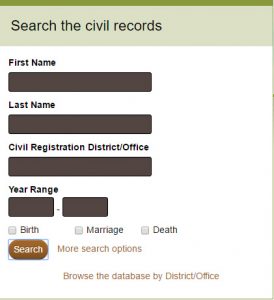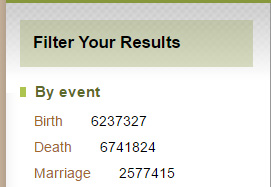How best to use all the new records we have at IrishGenealogy.ie? They consist of:
- images of 6.2 million births 1864-1915;
- images of 1.2 million marriage records, 1882 – 1940;
- images of 4.2 million death records, 1891 – 1965.

Why am I harping on about images and not just records? Because they are precisely images only. There is no searchable database transcript that would, for example, allow you to pick out only Presbyterian marriages, or narrow your search for deaths to a particular townland. The only route of access to the images is the index, which simply points to the image of the page on which the indexed event is recorded: for all recorded births, starting in 1864, and for marriages and deaths from 1882 and 1891 respectively.

(Incidentally, I think the absence of the early deaths and marriage images has produced a perverse increase in the numbers buying printouts; the easy availability of the later images has made the earlier ones all the more desirable. Download the request form here if you really need that itch scratched. )
The IrishGenealogy index is not the only route into the record images, however. The Mormons’ FamilySearch has a full copy of a (flawed) transcript of the old paper indexes, right up to 1958, very useful for twentieth-century births and marriages. And they also have a part-transcript of the birth registers from 1864 to the first quarter of 1881. Which means you can search on both parents’ names on that site and then use the results to see the full original image on IrishGenealogy.
Rootsireland provides another way in. They have plenty of transcripts of local registrar’s records, of which the IrishGenealogy records are copies, many of them coming right up to 1920. Counties with significant numbers are Armagh, Derry, Donegal (excellent), Galway, Kilkenny, Leitrim, Limerick, Mayo, Roscommon, Sligo, Tipperary, Waterford. As always with Rootsireland, keep a close eye on what you are and aren’t searching and don’t be put off by their categorising records into local Registrars Districts rather than the larger Superintendent Registrar’s districts used by IrishGenealogy. You can see which local districts are in the Superintendents’ districts via the map here. Logainm has detailed maps showing the locations of the local districts.
And of course Rootsireland has its church baptism, marriage and burial transcripts, useful proxies for a civil registration index, especially where a surname is common. The site, it should be said, has improved out of all recognition over the past year. It remains the only essential Irish genealogy subscription site.
For areas now in Northern Ireland, the General Register Office of Northern Ireland’s geni.nidirect.gov.uk is also extremely useful, especially for periods not yet imaged on IrishGenealogy. For imaged periods, their database transcript is excellent for pinpointing records, though most users will then slink off to IrishGenealogy for the free image rather than pay on the NI site. It wasn’t very neighbourly of our Department to drive a tank through GRONI’s business model without any warning, but the result is wonderful for researchers. Neighbourliness be damned.
If you’ve ever managed to get your hands on the original local registrar’s volumes, you’ll know just how useful it can be to go through a local area page by page, volume by volume, year by year. Patterns emerge that aren’t apparent anywhere else – pairs of siblings marrying each other, local epidemics, occupations clustering in a particular village.
So is it possible to use these new images to reproduce the original volumes? Yes, though with difficulty. This is what you see at the top of a register page-image: ![]() That final number “2253803” is the one you need to change in order to navigate. Add 1 to move a page forward, subtract 1 to move a page back. By doing this you can browse the local registrar’s records. But only for a single three-month period, because the records were copied to the central GRO every quarter. After that you need to find the next quarter, not always easy because there appears to be no discernible pattern to the way the imaging took place: it’s not alphabetical by SRD nor RD nor county.
That final number “2253803” is the one you need to change in order to navigate. Add 1 to move a page forward, subtract 1 to move a page back. By doing this you can browse the local registrar’s records. But only for a single three-month period, because the records were copied to the central GRO every quarter. After that you need to find the next quarter, not always easy because there appears to be no discernible pattern to the way the imaging took place: it’s not alphabetical by SRD nor RD nor county.
So there is a job of work to be done here, mapping the locations of the start pages of each quarter for each RD. And it’s a big job of work. For births alone there are 61 years, multiplied by four quarters, multiplied by 865 Registrar’s Districts, for a total of 211,060 points to map.
Get cracking.
I know of nobody better equipped to undertake such a task than one John Grenham…. 🙂
Thanks for such a comprehensive guide to maximising the benefit from this recent genealogical windfall.
One item to highlight is that Rootsireland has local registrar’s volumes. The death of my great great grandfather was in the local registrar copy, but not in Dublin.